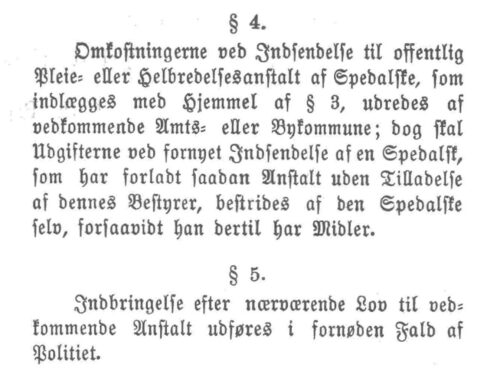Application of the law – coercion or education?
According to the legislation, not all of those with leprosy had to be isolated in an institution, but could remain living at home on the condition that they could provide for themselves and keep a satisfactory distance from others. Only those receiving poor relief or who refused to follow the guidelines could be forcibly hospitalised. From one of the medical districts in Sogn, it was pointed out that the law’s ‘Coercive Measures’ would likely only be used in exceptional circumstances. The mere existence of the law had already prompted improvement by encouraging those with leprosy living at home to exercise a greater degree of caution.
Edvard Kaurin, a physician at Reknes Hospital, wrote in 1893 that of the 99 people admitted in the period 1885–1892, only 14 were admitted using the legislation. Of these, eight ‘patiently accepted their fate’ and subsequently enjoyed their stay, while five ended up leaving the hospital. The reason for all these admissions was that the patients could not or would not isolate themselves at home. As an example, Kaurin describes one person that shared a bed with their children, while others took up work and had contact with the wider community. His assessment was that it was not inhumane to enforce the law, but that on the contrary, it would be irresponsible not to put to an end to this recklessness.
The physicians’ reports in ‘Tables of People Diagnosed with Leprosy in Norway’ show the proportion of new forced admissions to Reitegjerdet Hospital:
1891–1895: 13 of 130 new residents
1896–1900: 13 of 101
1901–1905: 13 of 95
1906–1910: 7 of 53
1911–1915: 0 of 22
The coercion clause was not often used at Pleiestiftelsen either. Between 1896 and 1900, two women were admitted against their will, and one young man was brought ashore after taking a job on a ship, despite it being prohibited by his district medical officer. Between 1901–1905, two women were also admitted by force. One of them, who ‘did not want to be separated from her husband’, was transported to the hospital by the local sheriff. During the next five years, a former teacher was admitted with police assistance. He initially moved in voluntarily but subsequently ran away and had to be forcibly readmitted.
During the debate that took place after the act was enacted, several physicians expressed a hope that the law and its coercion clause would not have to be enforced, and that largely turned out to be the case. Nevertheless, the law contributed to limiting contact with others and reduced the risk of transmission, as those with leprosy living at home knew they had to comply with orders or face being hospitalised. The physician Kaurin describes the legislation as having an ‘educational power’, and that it ‘without doubt has borne and will continue to bear its good fruits across the nation’.

From the proposal from the Committee on Business and Industry in April 1885.
www.stortinget.no



